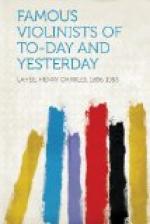One day, during the service, a gust of wind blew aside the curtain behind which Tartini was playing, and a Paduan, who remembered the archbishop’s wrath and recognised the object of it, carried the news of his discovery to the worthy prelate. Time had, however, mollified him, and instead of still further persecuting the refugee, he gave his consent to the union of the young couple, and Tartini and his wife went to Venice, where he intended to follow the profession of a violinist.
Here he met and heard Francesco Maria Veracini, who was some seven years his senior, and whose style of playing made such a deep impression on him that he at once withdrew to Ancona, to correct the errors of his own technique, which, as he was self-taught, were not a few.
After some years of study and retirement, he reappeared at Padua, where he was appointed solo violinist in the chapel of San Antonio, the choir and orchestra of which already enjoyed a high reputation. It is said that the performance of Veracini had an effect upon Tartini beyond that of causing him to quit Venice. It made him dream, and the dream as told by Tartini himself to M. de Lalande is as follows:
“He dreamed one night (in 1713) that he had made a compact with the devil, who promised to be at his service on all occasions; and, during this vision, everything succeeded according to his mind; his wishes were anticipated, and his desires always surpassed, by the assistance of his new servant. In short, he imagined that he presented the devil with his violin, in order to discover what kind of a musician he was, when, to his great astonishment, he heard him play a solo so singularly beautiful, which he executed with such superior taste and precision, that it surpassed all the music he had ever heard or conceived in his life. So great was his surprise, and so exquisite his delight upon this occasion, that it deprived him of the power of breathing. He awoke with the violence of his sensations, and instantly seized his fiddle in hopes of expressing what he had just heard; but in vain. He, however, directly composed a piece, which is perhaps the best of all his works, and called it the ‘Devil’s Sonata;’ he knew it, however, to be so inferior to what his sleep had produced, that he stated he would have broken his instrument, and abandoned music for ever, if he could have subsisted by other means.”
This composition is said to have secured for him the position in the chapel of San Antonio, where he remained until 1723, in which year he was invited to play at the coronation festivities of Charles VI. at Prague. On this occasion he met Count Kinsky, a rich and enthusiastic amateur, who kept an excellent private orchestra. Tartini was engaged as conductor and remained in that position three years, then returning to his old post at Padua, from which nothing induced him to part, except for brief intervals. At Padua Tartini carried on the chief work of his life and established the Paduan school of violin playing. His ability as a teacher is proved by the large number of excellent pupils he formed. Nardini, Bini, Manfredi, Ferrari, Graun, and Lahoussaye are among the most eminent, and were attached to him by bonds of most intimate friendship to his life’s end.




